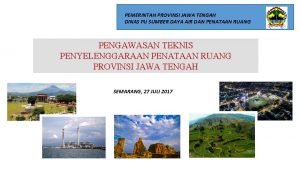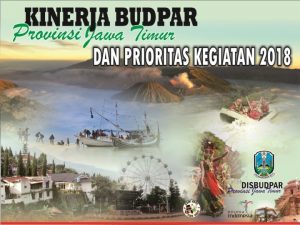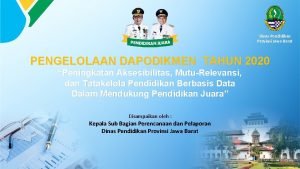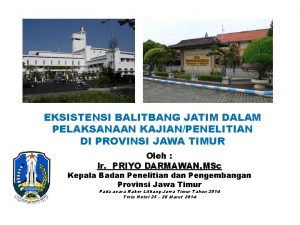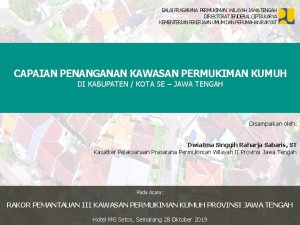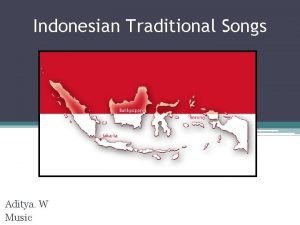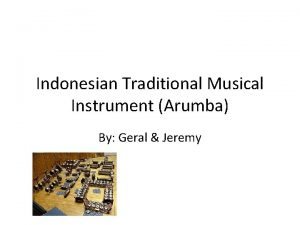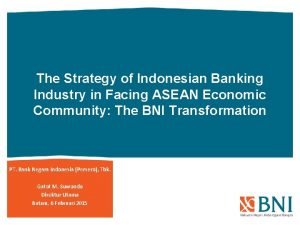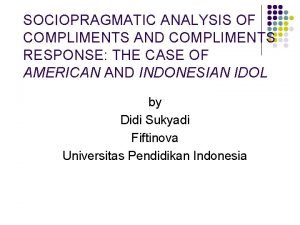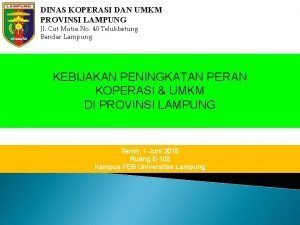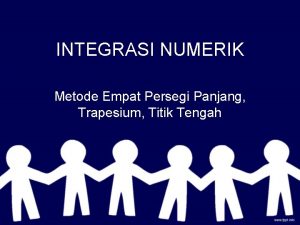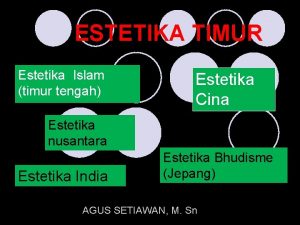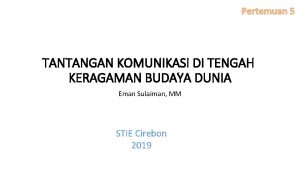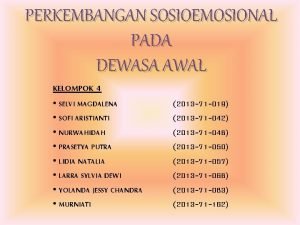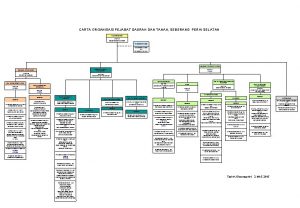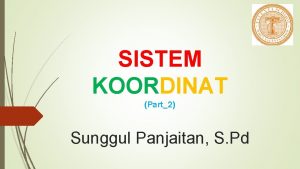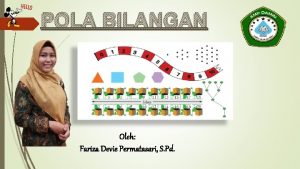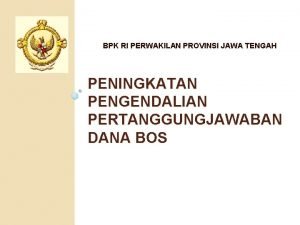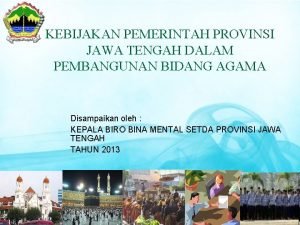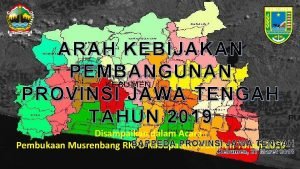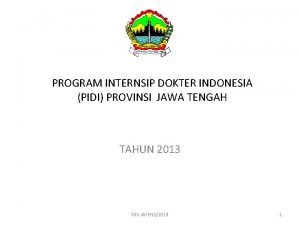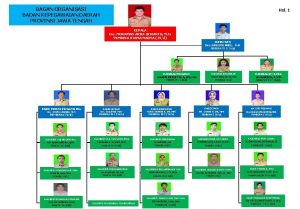CENTRAL JAVA Central Java Indonesian Provinsi Jawa Tengah



























































- Slides: 59

CENTRAL JAVA

�Central Java (Indonesian: Provinsi Jawa Tengah) is a province of Indonesia. The administrative capital is Semarang. It is one of six provinces on the island of Java. The province of Central Java is 32, 548. 20 km 2 in area; approximately a quarter of the total land area of Java. Its population is 32, 864, 000 (As of 2009[update]), making it the third most-populous province in Indonesia after West Java and East Java.


I. Traditional House: Joglo


II. Traditional Clothes �Traditional Dress �Women's traditional dress, especially in Yogya and Solo court families, consisting of : �Jarit or Tapih or Sinjang A 'kain panjang' (long cloth of batik) measuring around 2 m x 1 m to cover the lower body, tightened with stagen (large waist band) �Kebaya It is a traditional long sleeved shirt (the material used is not from batik, usually from silk and other fine materials). Selendang It is used as attractive piece of clothing to compliment the traditional dress. The 2 m x 0, 5 m selendang cloth hung over one shoulder. Kemben or Semekan It is special for ceremonies in Karaton (palace) or Royal family ceremonies. Instead of wearing Kebaya, to cover the upper body, a kemben is worn.

�Men's Traditional Dresses Jarit or Bebed Men kain panjang, tightened with stagen. Surjan Men traditional long sleeved shirt (only for Yogya style) and the material is not batik. Beskap Instead of wearing surjan, the men wear a coat (beskap of Solo style or Atila of Yogya style), the materials is not batik. Blangkon It is a headgear made from batik. Keris The dagger is worn at backside of the waist, as a compliment to the dress. �Dodot. Is a very long jarit to cover the lower body. It is worn only on a very special occasion such as the king coronation by the king himself. The wearing of dodot or kampuhan is very complicated. It may take two hours to wear a dodot with the help of specialist-dressers!





III. JAVANESE ARTS

1. Wayang �There is no evidence that wayang existed before Hinduism came to Southeast Asia sometime in the First Century. �The first record of a wayang performance is from an inscription dated 930 CE which says "si Galigi mawayang, " or "Sir Galigi played wayang".

a. Wayang Kulit �Kulit means skin and refers to the leather construction of the puppets that are carefully chiseled with very fine tools and supported with carefully shaped buffalo horn handles and control rods. �The stories are from the Ramayana, the Mahabharata or the Serat Menak.





b. Wayang wong �Wayang wong is a type of theatrical performance with themes from the kingdom of Jenggala, in which the players wear masks known as wayang topeng or wayang gedog. �The word "gedog" comes from "kedok", which, like "topeng" means "mask".


3. Batik


The making of batik


2. Gamelan �In his book 'music of Java' Jaap Kunst says, "Gamelan is comparable to only two things, moonlight and flowing water. . mysterious like moonlight and always changing like flowing water. . . ” �There are two kinds of laras (tuning) in gamelan, namely slendro (comparable to minor key in Western music) and Pelog (major key). �A complete set of gamelan consist of two sets of different instruments of Slendro and Pelog,





Bonang

Gendang

Gong

Saron

Songs

� Cublak 2 suweng Suwengi ting gelender Mambu ketundhung gudel Pak gempong lera lere Sopo ngguyu ndelekake sir. . . sir pong dele kopong 2 X � Gundul 2 pacul Gembelengan Nyunggi 2 wakul Gembelengan Wakul nggelempang Segane dadi sak latar! 2 X � Suwe ora jamu Jamu godong telo Suwe ora ketemu Temu pisan gawe gelo

Gambang suling �Gambang suling ngumandang swarane Tulat tulit kepenak unine Unine mung nrenyuh ake Barengan lan kentrung ketipung suling Sigrak kendangane kacang karo roti adi diparingi

Dances Classical Court Dance The famous court dances which are available up to present date are Bedoyo and Srimpi. �Bedoyo is sacred court dance performed by nine girlsdancers. All the performers must be in the holy state, physically and souly, this is a mythological dance depicting the meeting between Panembahan Senopati, the first ruler of the Mataram Kingdom II with Kanjeng Ratu Kidul, the powerful and beautiful goddess-the Queen of South Sea. The gamelan accompaniment reflecting the voices of sea wind and other natural voices. For those who has learned in depth mysticism, during the dance performance, a tenth "invisible" dancer appears. It is said that she is a very beautiful princess, dancing impressively elegant. Some said that Bedoyo dance is sacred, as it is symbolizing a meditator’s highest achievement during samedi (medititation) by closing 9 human orifices & deflating all bad desires

Bedoyo dance �Bedoyo is sacred court dance performed by nine girls-dancers. �All the performers must be in the holy state, physically and souly, this is a mythological dance depicting the meeting between Panembahan Senopati, the first ruler of the Mataram Kingdom II with Kanjeng Ratu Kidul, the powerful and beautiful goddess-the Queen of South Sea. �The gamelan accompaniment reflecting the voices of sea wind and other natural voices.


Srimpi dance �This dance is also a sacred dance performed by four girls-dancers. �The Srimpi dance originally performed in the Pendopo (open hall) of Javanese mansion with four main pillars in the middle. �It is believed when Srimpi dance is performed correctly, it should give magical power. The dance has a very soft movement depicting a good moral behavior. �The dancers have the same dresses and make up, wish that people not to be jealous one to another.


Petilan Dance � 3. Petilan This dance describing a part of a story e. g the fight between two warriors e. g Srikandi against Larasati. In the Petilan dance it could describe a fight between two warriors or movements of adoration between two lovers. In fact the movements are almost the same, only the topic is different. Probably the movement in love or in a fight sometimes is slow and the other times flare up.

IV. Tools and Weapons


Weapons �KERIS is The most famous pusaka or heirloom for Javanese people is Keris (dagger). In the ancient time, a man is not considered as a real man if he has no keris. The keris is highly valued, treated and respected with special care. �This pusaka is usually inherited from fore fathers. According to Javanese ancient tradition, especially in the court families, a father was obliged to give to his adult son at least a keris. The process of the making of the blade in the old days may last one year only for one keris. The keris maker is called an Empu. Only the respectable Empus could make a high quality keris, physically and spiritually. Empu has to do some spiritual deeds to prepare a keris, like fasting, not sleeping for several days and nights, meditation, etc.

Keris


Traditional Wedding �THE PREPARATION OF A WEDDING CEREMONY A sincere and mutual love between a woman and a man should end in marriage. In places like Java, the marriage occurred due to the decision by a loving couple. This is a matter of principle since the ancient time. It could hoppened due to the wish of their parents. A Javanese proverb says: "'Tresno jalaran saka kulino" means "love grows when you are get used to each other". Up to now, a Javanese always stays close to the family. Family solidarity is of prime important. The loving couple should inform their parents accordingly and several steps should be taken to prepare the wedding.

�The Proposal The parents of the man (would be bridegroom) should send an envoy or envoys to the parents of the woman (would be bride), proposing that their son is willing to marry their daughter. Nowadays, for practical reason, the parents of both sides could talk directly. The parents of the couple should approved the planned marriage. They should fix convenient and good days of wedding procedures which must be followed such as Peningsetan (traditional engagement), Siraman (holy bathing), Midodaremi (ceremony in the eve of the wedding day), the Panggih and other traditional rituals. Usually, the parents of the would be bride have a greater say as they are the ones who organize the ceremony. It should be decided also what kind of marriage pattern is chosen, among other Paes Ageng (great make up) or Kesatrian (knight's make up which is simpler). Every marriage pattern differs in make up and dresses for the bride and bridegroom. It should be decided also what kind of dresses the parents should wear, what kind of Batik pattern and shirt/coat design, which color etc.


Transportations

Andong


V. Foods and Drinks �Rice is the staple food of Central Java. In addition to rice, dried cassava known locally as gaplèk also serve as staple food. Javanese food tends to taste sweet. Cooked and stewed vegetables, usually in coconut milk (santen in Javanese) are popular. �Saltwater fish, both fresh and dried is common, especially among coastal populations. Freshwater fish is not popular in Central Java, unlike in West Java, except perhaps for catfish known locally as lélé. Catfish is usually fried and served with chilli condiment (sambal) and raw vegetables. �Chicken, mutton and beef are common meat. Although the majority of Central Javanese are Muslims, pork is common, especially around Semarang and Surakarta. Dog meat, known by its euphemism daging jamu (literally "traditional medicine meat") is also occasionally eaten by certain parts of the population.

�Tofu and tempe serve as common fish and meat replacement. Famous Central Javanese dishes include gudeg (sweet stew of jackfruit) and sayur lodeh (vegetables cooked in coconut milk). �Besides the aforementioned tofu, there is strong Chinese influence in many dishes. Some examples of Sino-Javanese food are noodles, bakso (meatballs), lumpia, soto (some kind of soup made with chicken or beef) et cetera. The widespread use of sweet soybeans sauce (kecap manis) in the Javanese cuisine can also be attributed to Chinese influence.

Tumpeng


Gudeg

Tengkleng
 Simpeg provinsi maluku
Simpeg provinsi maluku Provinsi jawa tengah
Provinsi jawa tengah Inspektorat jabar
Inspektorat jabar Ripparprov jawa timur
Ripparprov jawa timur Renstra dinas pendidikan provinsi jawa barat
Renstra dinas pendidikan provinsi jawa barat Visi dan misi dinas pendidikan provinsi jawa barat
Visi dan misi dinas pendidikan provinsi jawa barat Badan akreditasi provinsi jawa timur
Badan akreditasi provinsi jawa timur Dinas perindustrian dan perdagangan provinsi jawa timur
Dinas perindustrian dan perdagangan provinsi jawa timur Balitbang provinsi jawa timur
Balitbang provinsi jawa timur Dinas perindustrian dan perdagangan provinsi jawa timur
Dinas perindustrian dan perdagangan provinsi jawa timur Inspektorat provinsi jawa barat
Inspektorat provinsi jawa barat Pis pk jateng
Pis pk jateng Balai prasarana permukiman wilayah jawa tengah
Balai prasarana permukiman wilayah jawa tengah S invest ksei
S invest ksei Indonesian professional certification authority
Indonesian professional certification authority Verbs with j
Verbs with j Traditional song indonesia
Traditional song indonesia Seato countries
Seato countries Indonesian youth diplomacy
Indonesian youth diplomacy Indonesian traditional instruments
Indonesian traditional instruments Indonesian folk song
Indonesian folk song American indonesian exchange foundation
American indonesian exchange foundation Indonsia
Indonsia Asean banking integration framework
Asean banking integration framework American idol
American idol Indonesian medical council
Indonesian medical council Si patokaan lyrics english
Si patokaan lyrics english Vce indonesian
Vce indonesian Biro kesos dki jakarta
Biro kesos dki jakarta Kostum tari radap rahayu
Kostum tari radap rahayu Honorarium
Honorarium Jambi provinsi mana
Jambi provinsi mana Provinsi
Provinsi Tugas komisi penilai amdal
Tugas komisi penilai amdal Bkkbn
Bkkbn Jumlah umkm di provinsi lampung
Jumlah umkm di provinsi lampung Provinsi sumatera selatan
Provinsi sumatera selatan Provinsi kalimantan timur
Provinsi kalimantan timur Provinsi kalimantan timur
Provinsi kalimantan timur Simpeg bkd dki jakarta
Simpeg bkd dki jakarta Dinas pemberdayaan masyarakat dan desa provinsi bali
Dinas pemberdayaan masyarakat dan desa provinsi bali Rataan peubah acak
Rataan peubah acak Peta daerah melaka tengah
Peta daerah melaka tengah Perkembangan kognitif dewasa madya
Perkembangan kognitif dewasa madya Uji nilai tengah
Uji nilai tengah Metode persegi
Metode persegi Kaidah titik tengah
Kaidah titik tengah Estetika timur tengah
Estetika timur tengah Tabel kurva normal
Tabel kurva normal Tantangan komunikasi di tengah keragaman budaya dunia
Tantangan komunikasi di tengah keragaman budaya dunia Bagian tengah navigator palette disebut…
Bagian tengah navigator palette disebut… Tuliskan peran keluarga ditengah gaya hidup modern
Tuliskan peran keluarga ditengah gaya hidup modern Hak dan kewajiban orang beriman dalam masyarakat
Hak dan kewajiban orang beriman dalam masyarakat Dewasa awal tengah dan akhir
Dewasa awal tengah dan akhir Carta organisasi pejabat daerah muar
Carta organisasi pejabat daerah muar Rumah gedung
Rumah gedung Titik l terletak pada koordinat
Titik l terletak pada koordinat Biji pada bagian tengah bunga daisy
Biji pada bagian tengah bunga daisy Maksud pesanan pukal
Maksud pesanan pukal Contoh kata bebas
Contoh kata bebas

